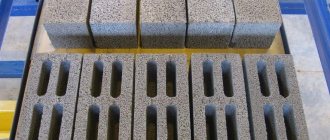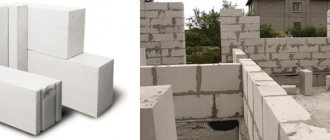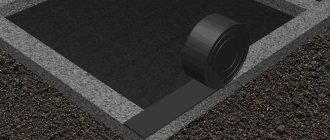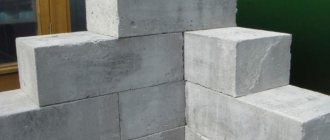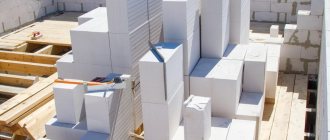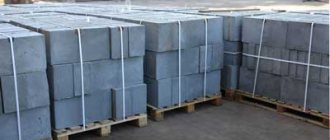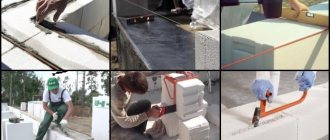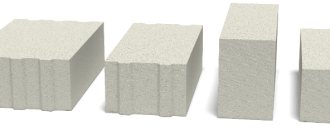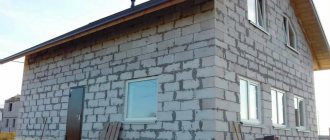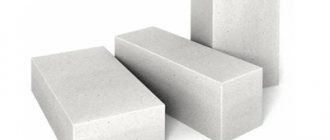Aerated concrete is a lightweight and porous material that has mediocre sound insulation. Let's first figure out where sound insulation is needed most and what types of noise there are.
Some new buildings suffer most from excess noise, in which the partition walls between apartments and rooms are too thin, and various sounds can be heard from neighbors.
Such partitions are most often made of aerated concrete, but thin low-density aerated concrete has poor sound insulation, so you need to increase the wall thickness or density.
Types of noise
Different building materials react to sounds differently. Before considering the materials used for sound insulation, it is necessary to determine what noise is. Noise is unwanted sounds that vary in strength and frequency.
Aerated concrete block
There are airborne and impact types of noise. Airborne noise is sound waves passing through a medium and, when interacting with enclosing structures, creating oscillatory movements that spread further into adjacent rooms.
Impact noise is caused by shock or vibration loads on structures and travels directly through them. To stop the spread of noise, acoustic materials are used to absorb and reduce the strength of sound vibrations.
According to SNiP, the required sound insulation coefficient in an apartment (average sound absorption coefficient) is determined by the formula: acp = A / Sogr, where A is the sound absorption area, expressed in sq.m.; Sogr – total area of enclosing structures, sq.m. Most often, the sound absorption coefficient of insulation is 0.5 - this means that a wall made of insulation absorbs up to half of the noise energy falling on it.
What types of noise are there?
The nature of noise varies, as do the types.
- Airy (human voices, sounds of music, natural phenomena).
- Structural (impacts of objects when falling, knocking of doors, sounds of steps, claps).
- Impact (the result of any mechanical work, construction machinery and equipment - very important in industrial premises).
In city houses, the walls between apartments and various public institutions (shops, gyms, restaurants and cafes) have the highest sound insulation rates. Rw 55-60 dB.
Aerated concrete plaster
Another option for improving the sound insulation of aerated concrete is plastering on both sides. It is used for thin walls, together with reinforcement it gives additional strength. Plastering will prevent moisture from getting inside the blocks; the finishing material should protect the material from destruction on both sides.
One of the disadvantages of aerated concrete is its low moisture resistance. In the case when it is the only building material, plaster is carried out outside and inside the building. Plaster for aerated concrete is selected especially carefully, because it serves not only to preserve its properties, but also to improve them.
How to choose optimal sound insulation
After completing the preliminary work, you can begin soundproofing the premises. Soundproofing systems can be framed or frameless. The frame consists of anti-noise material covered with gypsum fiber (GVL) and plasterboard sheets (GKL). The system without a frame consists of already prepared gypsum plasterboard sheets with glued slabs, on which gypsum plasterboard sheathing is placed.
Frame systems have a number of advantages, including:
•they mechanically level the surface, the walls are smooth without plaster;
•the number of mounting points is three to four times less than for frameless ones, and this reduces possible vibration loads on the slabs;
•the frame can withstand increased loads - you can hang a TV or air conditioner on it, for example;
•no specialists are required during installation; work is carried out using standard KNAUF technology.
Aerated concrete primer
You can use a roller or brush to apply the primer. Aerated concrete has increased absorbency, and this makes its priming difficult. You will have to repeat this operation 2-3 times.
The choice of primers in stores is impressive, so you can choose the right one yourself. Often the plaster is reinforced with reinforced mesh and the plaster is applied over it.
This is necessary when plastering the facade of a house. Finishing begins from the inside, because... There are different humidity levels for external and internal walls. And while you are plastering from the inside, all the moisture will leave through the outer wall.
Sound insulation index of aerated concrete airborne noise
A little theory about noise. Sound itself can be divided into three types, each of which has its own frequency and travels through different materials in different ways.
Impact (vibration) - a blow passes through the wall, and vibrations begin in it, which create an audible sound on both sides of the wall. Vibration noise travels very far, passing through walls, floors and ceilings, since the structures are rigidly connected to each other. Such noise includes: hammering, objects falling on the floor, stomping.
Airborne noise (wave noise) is the most common and frequent type of noise, which is produced by the human voice, TV, barking dogs, etc. The sound wave spreads in all directions, part of the sound wave is reflected from the walls, part is damped, and part of the sound can pass through the wall.
Structural noise is an intermediate type of noise between shock and wave, sources are: garbage chute, pipes, elevator, ventilation system.
Interior walls based on metal frames
And yet, the best option for interior walls in an apartment is plasterboard partitions with sound-absorbing boards inside. Photographs of the construction of such a partition in one of the Moscow new buildings are given at the beginning of the article.
Such interior walls, even in the basic version, will provide significantly better sound insulation between rooms than partitions made of tongue-and-groove (or foam block). The sound insulation of interior walls made of plasterboard 100 mm thick is R
w = 52 dB
(which is 11 dB better than that of a tongue-and-groove plasterboard and 15 dB better than that of a foam block)!
But the most important advantage of this solution is that virtually no vibrations from the floors are transferred to the frame structures and the problem of noise re-radiation from neighbors above and below is automatically solved!
There are several common misconceptions associated with plasterboard partitions:
Weak load-bearing capacity. Fragility
In fact, partitions on a metal frame are very durable. You just need to do them correctly:
- use only branded KNAUF
or Gyprok profiles with normal metal thickness and reinforcing longitudinal grooves. - the rack profiles are fastened with their backs to each other to form an I-beam.
- inside the partition, sound-absorbing plates are tightly inserted between the profiles.
- on both sides the frame is covered with cladding made of 10 mm GVL + 12.5 mm GKL.
Such a wall will be very strong and have a high load-bearing capacity: cantilever loads up to 70 kg! You can safely hang a TV, an air conditioner or shelves with books. You can read more about the load-bearing capacity of partitions here.
Large thickness
This myth is easily refuted. We count the thickness from left to right:
GKL 12.5 mm + GVL 10 mm + KNAUF profile 50 mm + GVL 10 mm + GKL 12.5 mm = 95 mm.
The finishing surface of such a wall is smooth; it is enough to apply a thin layer of putty to hide the joints between the sheets of drywall. Add another 5 mm and get a final thickness of 10 cm
with finishing.
This is the standard thickness for interior walls in an apartment.
High price
A square meter of conventional KNAUF PGP slabs, calculated per 1 m2, costs 700-800 rubles. You also need to add to this: tile adhesive, metal reinforcing corners, plaster and other little things. As a result, a square meter of such a wall rarely costs less than 1000 rubles.
Let’s now calculate the cost of a metal frame partition:
150 rub./m 2
- GVL 10 mm - 2 x 160 = 320 rub./m 2
- GKL 12.5 mm – 2 x 100 = 200 rub./m 2
- sound-absorbing boards
The total is 870 rubles/
m2
.
Let's add screws, silicone sealant and other little things. As a result, the amount will be the same (
1000 rub./m2), as in the case of a conventional plasterboard/foam block wall.
Those. there is no difference in cost, and the sound insulation of interior walls on a metal frame will be noticeably better!
If you need high-quality sound insulation and professional installation, please contact us! Our specialists will put together proven circuits that will reliably protect you from the noise of your neighbors. The visit of a specialist for measurements and consultation is free in Moscow and the region!
Dmitriy. Installation engineer 8 (916) 575-26-10
Nikita. Physicist-acoustics 8
Add a comment Cancel reply
Hello. “...additional sound insulation of the existing partition. It can be sheathed with thin patterns from 3 to 5 cm.” And what material?
Tell me what to do in our situation. Our house is brick, but the wall between the rooms is made of blocks, like the neighbors above. That is, the sound echoes along this wall. What soundproofing should we do?
Tanya, good afternoon! If you hear sound from a neighbor from the wall, then there are two options: a) demolish the partition and rebuild it from plasterboard with sound insulation. b) we perform additional sound insulation of the existing partition. It can be sheathed with thin patterns from 3 to 5 cm. The only thing is that if the noise needs to be reduced in two rooms, then the partition needs to be sheathed with noise insulation on both sides. If you need additional advice, write/call!
We agree, and the sound insulation of partitions in this case will be higher than that of tongue-and-groove walls or foam blocks!
fast construction using dry technology. Particularly important for cosmetic repairs or tight deadlines;
The price per square meter includes: 1) Sound-absorbing materials, vibration suspensions (for the ceiling), acoustic sealant. 2) KNAUF building materials (profiles, plasterboard, gypsum fiber sheets, screws, covering material (hardboard, polyethylene). 3) installation work. 4) organizational expenses (delivery, unloading, lifting material, cleaning).
Regarding the soundproofing of the ceiling, your problem is typical, but let me tell you in detail what and how (I think the information will be useful to everyone):
There are two types of noise: airborne (voices, screams, dog barking) and structural/impact (footsteps, jumping, moving furniture, falling objects, creaks, etc.). If you are only bothered by airborne noise, then soundproofing the ceiling alone will completely solve the problem (the noise will be reduced to almost background levels). You won't hear your neighbors. If impact noise is a concern, then soundproofing only the ceiling partially solves the problem. The fact is that this type of noise occurs due to impacts on the floor slab, which as a result causes vibrations of the latter, which can spread throughout the entire frame of the building. Therefore, impact noise is transmitted not only directly through the ceiling, but also indirectly along the walls. Depending on the type of house (panel, brick, monolithic, block), and depending on the series of the house and the quality of construction of a particular section, indirect sound transmission may vary. Sometimes the noise is transmitted weakly through the walls, sometimes strongly. Everything is individual here.
If you want to completely get rid of noise, then you need to do the ceiling and all the walls in the room.
If you soundproof only the ceiling, then, in general, there will be only a partial reduction in noise. Those. The goal is not to completely get rid of noise, but to reduce it to a comfortable level (not annoying). If you understand this, you will like the effect. In addition, when soundproofing the ceiling, the spectrum of penetrating noise changes, the so-called. signal filtering. The most annoying mid frequencies are completely gone. Therefore, the noise becomes dull and no longer irritates a person (this is already the field of psychoacoustics). In any case, sound insulation begins from the ceiling and the wall, if necessary, can always be further soundproofed later.
INTERNAL WALLS AND PARTITIONS
4.14
Double walls or partitions are usually designed with rigid connections between elements along the contour or at individual points. The gap between structural elements must be at least 40 mm.
To increase the sound insulation of double walls and partitions, the following design measures are recommended:
— increasing the thickness of the gap between the elements of the double structure;
— elimination of rigid connections between elements of a double structure, as well as with structures adjacent to walls and partitions.
4.15
To increase the insulation of airborne noise by a wall or partition made of reinforced concrete, concrete, brick, etc., in some cases it is advisable to use additional cladding on the side.
The following can be used as sheathing material: plasterboard and gypsum fiber sheets, solid wood fiber boards and similar sheet materials attached to the wall along wooden slats, along linear or point beacons made of gypsum or cement-sand mortar, over a metal frame. It is advisable to make the air gap between the wall and the cladding 40 - 60 mm thick and fill it with soft sound-absorbing material (mineral wool or fiberglass boards, etc.). The optimal thickness of the sound absorber is the thickness of the air gap.
4.16
Internal walls separating residential and built-in noisy rooms, which are subject to increased requirements for airborne noise insulation (required index
Rw
= 54 - 59 dB), should be designed as double walls with complete isolation of their elements from each other and from adjacent structures, excluding indirect sound transmission into insulated room along adjacent walls and ceilings. If acoustically homogeneous structures are used as such walls, measures must also be taken to reduce the intensity of indirect sound transmission through adjacent structures.
What is sound insulation, its features
Sound insulation is a system for suppressing unwanted sounds, which is implemented in the form of layers of insulation installed on walls and ceilings. There is a broader definition of sound insulation, as a set of measures aimed at reducing the conductivity of sounds by wall structures.
It is necessary to distinguish between two concepts - sound and noise. Sound is a single wave, but noise is made up of many sounds coming from different sources. Accordingly, soundproofing is a procedure aimed at removing the source or creating a barrier to sound waves. Noise insulation is a set of measures whose goal is to reduce noise levels. It is performed to eliminate the maximum number of sounds that make up the overall background noise.
For the residents of the house, these concepts do not have much meaning. It is important for people that it is quiet, no unnecessary sounds disturb them during the night or during the day. The need to understand the nature and origin of certain sound manifestations falls on the shoulders of specialists who carry out the procedure for eliminating noise and bringing their level to a sanitary standard. It is necessary to take into account that a whole range of measures are carried out in houses aimed at eliminating sources and increasing the impermeability of walls to sound waves. There is no point in fighting any single sound, since household noise, as a rule, includes dozens or hundreds of individual sounds. The problem is that they resonate and form new wave combinations that are difficult to identify and determine the sources.
Displaying beacons
Beacons are required to level the plaster. These are special guides of the required height. After use, the beacons can be carefully removed and used again if necessary. There are steel and plastic beacons for plaster. The disadvantage of plastic products is their excessive flexibility. Metal ones are much more practical.
There are also L-shaped and T-shaped beacons; The choice of section is determined by the tasks assigned to the profile. Beacons can be attached with a solution (on a cement-gypsum mixture) or using special fasteners (dowels, self-tapping screws, etc.).
You can display beacons using the artisanal method or the “spider” method. Each method has its own advantages and disadvantages. The cost of beacons starts from 4-5 rubles per meter. If necessary, you can order these products online at a lower price.
Sound insulation using foam block
The widespread development of industrial and residential construction with new installation technologies requires the use of effective soundproofing materials. Economically important is the use of building materials obtained from non-scarce cheap raw materials, but at the same time providing sufficiently high sound insulation rates when used in enclosing structures. Such materials include cellular concrete materials. A common property that determines the specificity and choice of applicability of structures made of cellular concrete is the content of a significant number of pores. If the cement stone is not specially porous, then the pores are contained only in the aggregate. The introduction of an air-entraining or gas-forming additive into the cement paste makes it possible to reduce the bulk density of lightweight concrete with porous aggregate. Due to porosity, the acoustic properties of cellular concrete are significantly improved compared to denser materials. The use of cellular concrete materials in wall structures with open or closed porosity makes it possible to increase their insulation index compared to walls made of homogeneous dense materials by 2...5 dB. The main characteristic that determines the acoustic properties is, in the terminology of SNiP 23-03-2003 “Protection from Noise”, the efficiency coefficient K. Here K is a coefficient that takes into account the relative increase in the flexural rigidity of a fence made of concrete with light aggregates, porous concrete, etc. in relation to structures made of heavy concrete with the same surface density. For continuous enclosing structures with a density y = 1,800 kg/m and more, K = 1. For continuous enclosing structures made of concrete with light aggregates, porous concrete; masonry made of bricks and hollow ceramic blocks > the K coefficient averaged by grade of material is determined according to SNiP and has values from 1.1 to 1.7, and for cellular concrete from 1.5 to 2. The K coefficient is closely related to the dynamic (initial) modulus elasticity of the material Ed dependence for solid-section structures made of lightweight concrete.
K = 0.72(U/p3)1/2,
where Ed is the dynamic modulus of elasticity of lightweight concrete Pa; p—density of cellular concrete, kg/m3.
To illustrate the above, Table 1 shows data on sound insulation of structures made of aerated concrete materials of density grades D600 and D800.
From Table 1 it can be seen that for the most common partition thicknesses in mass construction from 100 to 125 mm, the airborne noise insulation index Rw ranges from 29 to 43 dB. In accordance with the requirements of building codes for residential buildings, the required insulation index should be 41...50 dB (interior partitions). Therefore, to ensure the standards, it is necessary to use fences with a thickness of at least 125...250 mm, and not 80...100 mm as is currently practiced. The only alternative option for enhancing the soundproofing qualities of fences made of cellular concrete of small thicknesses is the combined use of additional double-sided gypsum plaster linings over a layer of mineral wool with a thickness of at least 40 mm. For external walls, sound insulation should be at least 35 dB, and for inter-apartment walls 50-54 dB, the thickness of which can be obtained from Table 1. Developed modern methods for assessing the sound insulation qualities of enclosing structures made of cellular concrete materials, based on experimental data from specialized Test Centers, allow for sufficient confidence to use them to ensure favorable acoustic conditions in housing.
Soundproofing walls
It is known that any room is limited by walls, which represent barriers to sound waves. These designs are divided into:
- Single-layer (homogeneous) structures - one or several layers, rigidly connected to each other over the entire surface and oscillating as one whole (plastered brick walls, etc.).
- Multilayer (heterogeneous) structures are several layers with different (sharply different) characteristics, not rigidly connected to each other, each of which is capable of oscillating with different amplitudes.
When constructing walls and partitions, first of all, airborne noise (voices, TV, music, etc.) is taken into account.
To protect against airborne noise, building acoustics (the science that deals with insulating buildings and premises from noise) distinguishes three main methods of sound attenuation:
- increasing the massiveness of fencing elements;
- use of sound-absorbing materials;
- sealing all possible penetration paths of airborne sound waves.
For load-bearing internal walls made of concrete or brick, the requirements for their sound insulation are almost always met automatically, because their thickness is calculated based on the load conditions on the wall.
Internal non-load-bearing partitions between apartments, rooms and other premises are most often made in lightweight versions, so here the main requirement for them is the necessary insulation of airborne noise.
Graph of the dependence of the airborne noise insulation index on the pressure on the floor structure
A difference in intensity of 10 dB is perceived by the hearing organs as a decrease in volume by 3 times. Sound insulation of 3 dB is perceived by a person as a decrease in volume by approximately 2 times!
Sound insulation standards
Walls and partitions between apartments. Rw≥52dB
Walls between apartments and shops. Rw≥55dB
Walls and partitions separating apartment premises from restaurants, cafes, gyms. Rw≥57 dB
Partitions without doors between rooms, between the kitchen and the room in the apartment. Rw≥43dB
Partitions between the bathroom and the room of one apartment. .Rw≥47dB
Sound insulation of single-layer walls and partitions
The sound insulation characteristics of such structures are determined, first of all, by their mass. The more massive the wall, the more sound it will reflect.
An indispensable condition is that the materials together with the binding solution form a sealed structure without any holes or cracks. Therefore, when designing a room, it is only by increasing the mass of the walls with proper tightness of the connections that the required sound insulation can be achieved.
Also, the porosity of the material used in its production plays a role in ensuring the soundproofing qualities of the partition. And yet, as practice shows, it is by and large impossible to achieve gains by increasing the porosity of the material due to more significant losses in sound insulation with a corresponding decrease in the surface density of such a material.
Characteristics
Airborne noise insulation index Rw, dB
Sound insulation of multilayer partitions
They alternate at least two layers: hard - from a high-density material with a high reflection coefficient (plasterboard, brick) and soft - from a material with a high sound absorption coefficient (mineral wool). Part of the sound wave is reflected by the first layer, and part is absorbed by the second. The amount of energy absorbed and dissipated depends on the thickness of the material, its density and elasticity.
Sound-absorbing materials
a special sound-absorbing material as a filler , and not ordinary insulation, although the latter is cheaper. The fact is that the acoustic properties of heat-insulating materials may differ several times from the similar properties of sound-absorbing materials. Thus, the average sound absorption coefficient of the most commonly used insulation materials is usually 0.4–0.5. This means that the material absorbs up to half of the energy of sound waves incident on it in a certain (standardized) frequency range. The indicator of special sound-absorbing material reaches 0.95. The conclusion is obvious: in order to achieve a certain effect, you need to use material designed to solve this particular problem.
How to improve the sound insulation of aerated concrete
Different tasks require different sound insulation. For example, you are recording sound and you need a room without extraneous sounds and without echo. Or you practice dancing, constantly jumping on the floor.
Sound insulation comes in three types:
- Soundproofing
- Sound-absorbing
- Damping
Soundproofing materials dampen wave noise at medium and high frequencies, while damping materials dampen low-frequency structural sound. Sound-absorbing materials absorb sound, preventing it from bouncing off the walls; such material is needed against the echo effect.
Ways to improve the sound insulation of aerated concrete:
- Plaster the wall with a thick layer.
- Using special soundproofing boards.
- Using mineral wool and drywall.
Plastering aerated concrete walls will increase the noise insulation index by 2-4 dB.
Conclusion. Dense aerated concrete (D500-D600) from 150 mm thick can be used as partitions, but still a brick wall insulates sound better. But there are times when a brick wall turns out to be too heavy for a house, and then it is necessary to use aerated concrete or structures made of profiles, plasterboard and mineral wool.
Another advantage of aerated concrete partitions is the speed and cost of masonry. Aerated concrete is cheaper, and the laying speed is higher. But the option of using plasterboard and soundproofing wool is also very good, because the weight of the partition is even less, and the sound will be retained better than with aerated concrete.
https://youtube.com/watch?v=MqgHJ4tFVWA
bik ton
When choosing a suitable material for construction, all its properties and qualities should be taken into account. Features and structure, rationality of use in given climatic conditions, efficiency. The noise insulation index is also one of the main characteristics that should influence this choice. The noise of the road near the house, the presence of children and animals in the house, a busy area filled with tourists and night entertainment venues - all these factors can literally ruin such a long-awaited vacation or deprive you of sleep and peace. The life of a big city and sometimes even country towns is filled with a variety of sounds. And not all of them are pleasant to our ears, for example, in the evening after a hard day at work. But this issue is most acute for residents of apartment buildings.
Cork covering
Improved sound insulation of aerated concrete blocks can be achieved by installing a cork covering. Soundproofing with cork is becoming more and more popular every day, and its advertising in construction stores is becoming more and more common. Cork is made from a natural material and is environmentally friendly; it does not emit foreign odors into the air of the room.
The material absorbs high-frequency sounds well. It may happen that you have noisy neighbors, then when covering oak with a layer of 1 cm with cork, you will not experience much of a difference before and after. The noise reduction will be about 18-20 dB (conversation is kept at a level of 45 dB, noise in offices is up to 60 dB).
Cork is supplied in sheets or rolls. Currently, the best producer of cork is Portugal. A new product in this area is cork spraying, applied with a spray gun and reaching a thickness of 3 cm.
For fastening it is better to use quick-setting rubber glue, then you won’t have to hold the slabs suspended for a long time
It is important to keep in mind that it is better to create several thin cork surfaces than one thick one.
Soundproofing a brick partition
Partitions made of red solid brick will have good sound insulation (hollow or sand-lime brick is not suitable). Red brick has high surface density and good internal losses.
The wall should be half a brick
(and not in a quarter) and must be plastered on both sides (total thickness ~140 mm). It is important not to skimp on cement mortar.
Building regulations prohibit the construction of brick walls in apartments
One could assume that we have found a suitable material, if not for one point that makes it impossible to use solid bricks in apartments! Current building codes prohibit the construction of brick partitions in apartment buildings - the floors are simply not designed for such a load!
About the disadvantages of aerated concrete blocks
Despite the many advantages of aerated concrete, it also has its disadvantages
When choosing a building material, it is very important to take into account all the parameters and criteria, since not only the reliability of the proposed structure, but also its service life depends on this
- Aerated concrete has a low compressive density, so it is considered brittle. The reliability of a partition or wall made of this material directly depends on the evenness and reliability of the foundation. If you plan to build using aerated concrete blocks, you should make a foundation that will give minimal shrinkage, otherwise the wall may crack and collapse.
- The material has a high degree of water absorption, which makes it quite difficult to carry out finishing work. It is not uncommon for the plaster to completely crumble. To work with aerated concrete walls, you should use a special soil mixture that can penetrate deeply into the middle of the block.
- Aerated concrete is not the best option for fastening massive decorative elements and furniture. In order to fix something on the wall surface, plastic dowels are not suitable; it is much more effective to use ordinary self-tapping screws. They fit well into the surface due to the airy structure of the blocks. The only thing that should not be forgotten is that the material absorbs moisture, which means that metal parts are subject to oxidation and rust. If you use self-tapping screws, then only those coated with a protective layer or galvanized. The problem can be prevented by using non-oxidizing metals.
To build your own home, you can use any type of building material; the main thing is to take into account all the advantages and disadvantages of the products when choosing. There is no ideal building material that would have all the qualities and characteristics; everyone has pros and cons. When selecting the appropriate material, you should approach it with full responsibility and calculation; only in this case can you get what you need.
This is interesting: Do-it-yourself barbecue made from foam blocks
Gas silicate or foam concrete blocks - which is better?
The modern market for building materials is so large that sometimes it is easy to get lost in this assortment, and it is also difficult to make the right choice. A comparison of their advantages and disadvantages will help you choose which is better - foam concrete or gas silicate. There are very few main conditions, but the quality of the constructed building largely depends on them.
General information
The main advantage of these building materials is their low price and low weight. This is the advantage of all cellular building materials. Although both of these materials are made of cellular concrete, they are fundamentally different from each other in manufacturing technology. And this affects the properties and characteristics.
Similarities and differences in manufacturing
Foam concrete and gas silicate have almost the same composition. The components that are present in both materials are water, cement, sand. Since these cellular compositions are identical, they have the following advantages:
- resistance to fire;
- resistance against mold, mildew, rot;
- resistance against damage to walls by various rodents;
- ease of installation.
The production of foam concrete is much simpler than gas silicate.
If you know the nuances of brickwork, then you can handle masonry with gas silicate or foam concrete on your own. It is for these reasons that most people face a choice - brick, gas silicate or foam concrete?
It is worth considering the nuances of manufacturing foam blocks, as well as gas silicate:
- The foam block is produced thanks to a production technology in which a foaming agent is added to the concrete solution. Only after this the resulting mass is poured into special molds, where it gains strength and strength.
- During the chemical reaction of unslaked lime with aluminum, gas silicate is made. The mass of this substance includes small parts of aluminum powder. As this reaction progresses, hydrogen rises to the top in the form of a gas, which forms a cellular structure. This material is produced in the form of large blocks. Gas silicate can be used only after the mass has hardened and been cut into the necessary blocks.
It is these differences in production that influence the characteristics of the resulting building materials.
Comparison of characteristics
To know which to give preference to, gas silicate or foam block, you must initially conduct a comparative analysis of their technical properties. Unfortunately, despite rapid technological development, there is still no building material that is ideal in all respects. For this reason, you have to make a choice based on an analysis of the advantages and disadvantages of foam blocks and gas silicate.
To find out which of these materials takes first place, we will need to conduct a comparative analysis based on the following characteristics:
- fortress;
- soundproofing;
- thermal insulation;
- environmental cleanliness;
- price;
- ability to absorb moisture;
- is reinforcement needed?
- the need for decoration or finishing;
- complexity of installation work;
- quality of manufactured materials.
Return to contents
Strength
In our country, we are accustomed to building houses so that they last for decades. If you take into account the prices of building materials, it becomes clear that this is not only better, but also simply necessary. Because of this, the desire to choose the most durable material for building walls becomes understandable. It must be remembered that the strength of gas silicate is much better than that of foam concrete. However, due to their reduced strength, such blocks are easily cut into the necessary parts, and it is easier to make holes or protrusions in them.
Gas silicate blocks provide much better resistance to various external loads. This helps them keep their original shape and not become colored during transportation or unloading. It follows from this that the erected building will be much stronger.
From this comparison it becomes clear that making a choice is difficult. Everything directly depends on what operations will be performed on the block. If it needs to be further processed, then foam concrete is better. If you need a building with strong and smooth walls, then gas silicate would be the best choice.
Soundproofing characteristics
Soundproofing properties table
Even at the design stage of a building, when choosing building materials, one should take into account such properties as sound insulation. Considering aerated concrete as a building material, one can note with satisfaction that its properties fully meet these requirements. During the production of blocks, a chemical reaction occurs between lime and aluminum powder. As a result of this process, the concrete composite foams. Aerated concrete is filled with air bubbles of various sizes. The cellular mass perfectly retains sound waves, and the blocks become light. It is known that the lower the density and the larger the volume, the higher the soundproofing qualities. Blocks fully possess these properties.
The value indicating the strength of sound is measured in decibels. Zero value is the lower threshold of human hearing. When studying the properties of building materials, a noise absorption index was derived. The permissible standard for residential premises is 41 dB. Walls built from aerated concrete blocks have a coefficient of 43-44 dB. Sound insulation is also measured by the sound absorption coefficient at a frequency of 1000 Hz. Autoclave coefficient - 0.2 Hz, wooden surface - 0.1 Hz, brick - 0.05 Hz, concrete - 0.02 Hz.
What types of noise are there?
The nature of noise varies, as do the types.
- Airy (human voices, sounds of music, natural phenomena).
- Structural (impacts of objects when falling, knocking of doors, sounds of steps, claps).
- Impact (the result of any mechanical work, construction machinery and equipment - very important in industrial premises).
In city houses, the walls between apartments and various public institutions (shops, gyms, restaurants and cafes) have the highest sound insulation rates. Rw 55-60 dB.
This is followed by the indicator between two neighboring apartments, walls separating the staircase space, lobbies and halls with living spaces - up to 50 dB. Partitions within one apartment will have sound insulation within the range of 41-45 dB.
An environmentally friendly material - aerated concrete, which has one of the highest sound insulation indices, will reliably protect against noise of any origin.
On sale you can find the following brands of aerated concrete that protect you from extraneous noise:
- Aerated concrete grade D400.
- Aerated concrete grade D500.
- Aerated concrete grade D600.
Depending on the brand of aerated concrete blocks and their thickness, the ability to soundproof will vary. The D600 has better performance. The indicators will increase by 2 dB. A building envelope made of D500 aerated concrete blocks with a thickness of 360 mm will give a noise insulation index of 48 dB.
Soundproofing characteristics of aerated concrete and other materials
A well-known property of materials is that they have high sound insulation properties with a lower density and large volume. Aerated concrete has exactly this structure. Obtained as a result of a chemical reaction between aluminum powder and lime, the light cellular mass of aerated concrete is filled with air bubbles. This composition of the material will be a good obstacle to the sound wave.
The noise absorption index for aerated concrete blocks is 43-44 dB. The standard for residential premises, derived from the properties of building materials, is 41 dB. The advantage of using this material is obvious.
Sound insulation can also be expressed by the sound absorption coefficient at a frequency of 1000 Hertz.
- Wooden surfaces - 0.1 Hz.
- Brick - 0.05 Hz.
- Concrete - 0.02 Hz.
- Autoclaved aerated concrete - 0.2 Hz.
- Concrete - 0.02 Hz.
Ways to enhance insulation from extraneous noise
Strengthening airborne noise insulation can be done in various ways.
- Plastering walls.
- Using finishing slabs.
- Materials that are multilayer structures.
Additional finishing of walls by plastering increases the noise insulation coefficient by 2-4 dB. This is the simplest and least expensive method. This method is also applicable to enhance the sound insulation of walls made of aerated concrete blocks.
With a wall thickness of aerated concrete blocks of 375 mm/400 kg.m 3, it will be possible to achieve a coefficient of 47 dB by additionally using putty and external plaster of the walls. Single-layer construction with a thickness of 100 mm. up to 300 mm, with a density of 400-600 m 3, will have an index in the range of 39-46 dB.
Puttying walls on both sides with aerated concrete block thickness from 100 to 150 mm and a density of 500-600 m 3, respectively, will give a result of 39-43 dB.
The data is given taking into account the proper implementation of all work on sound insulation, high-quality processing of seams, as well as the exclusion of various external factors that can weaken the insulation.
Various types of slabs can be used as additional cladding to increase sound insulation. Gypsum boards, acoustic mineral boards. Finishing with such a light and economical material as foam is very effective.
Penoplex and expanded polystyrene are the most popular types of foam. These materials are harmless to humans, lightweight and easy to use. The airborne noise level is reduced to 36 dB.
The use of aerated concrete blocks is effective in combination with various finishing materials.
An additional layer of mineral wool 30 mm thick is laid between the block and the finishing slab. Wooden beams or wooden blocks are also laid at some distance from the block. If required, waterproofing is installed. Such a system will improve the airborne noise level readings by 5-10 dB. An additional air gap of 75-100 mm will increase this figure to 20 dB.
Multilayer structures made of aerated concrete blocks
The level of airborne sound insulation is related to the thickness and density of the wall material. A wall made of cellular concrete materials with a multilayer structure will help achieve excellent performance in comparison with other materials.
The thickness of blocks in multilayer structures can be different in different parts of the wall. The presence of an air gap between the layers will increase the noise absorption coefficient. Rigid piles should not serve as fastening between layers, as this will significantly reduce the index and will not lead to the desired result.
Competitors of aerated concrete blocks
Due to the low cost of aerated concrete blocks, it is quite problematic to choose the material that is more suitable for construction. Among the closest competitors are ceramic bricks and foam concrete. All competing materials are similar in color, shape and other parameters. The main difference parameter is the density and structure of the product. Aerated concrete has a porous structure and lightweight structure. Depending on the proposed construction and the characteristics of the materials, the optimal price-quality ratio is selected.
Summarizing
Aerated concrete is a recently emerged building material with many advantages and benefits.
When choosing a material, it is important to look at the brand of the product, its dimensions and adhere to the manufacturer’s requirements. If you adhere to all the standards, you can choose the most suitable type of material for construction and sound insulation of the house
The variety of building materials today is quite large. Depending on the requirements and construction project, the most suitable material is selected. Despite the recent appearance of aerated concrete blocks, this building material has gained popularity for interior and exterior work. Using aerated concrete blocks, you can build a reliable and durable house that will have all the conditions for a comfortable life.
bik ton
When choosing a suitable material for construction, all its properties and qualities should be taken into account. Features and structure, rationality of use in given climatic conditions, efficiency. The noise insulation index is also one of the main characteristics that should influence this choice. The noise of the road near the house, the presence of children and animals in the house, a busy area filled with tourists and night entertainment venues - all these factors can literally ruin such a long-awaited vacation or deprive you of sleep and peace. The life of a big city and sometimes even country towns is filled with a variety of sounds. And not all of them are pleasant to our ears, for example, in the evening after a hard day at work. But this issue is most acute for residents of apartment buildings.
JOINTS AND KNOTS
4.17
The joints between internal enclosing structures, as well as between them and other adjacent structures, must be designed in such a way that, after construction and during the operation of the building, through cracks, crevices and leaks do not appear in them, which sharply reduce the sound insulation of the fences.
Joints in which during operation, despite the taken constructive measures, mutual movement of the joined elements under the influence of load, temperature and shrinkage deformations, are possible, should be constructed using durable sealing elastic materials and products glued to the joined surfaces.
4.18
Load-bearing elements of floors should be supported on internal and external walls or inserted into them. Free connection of load-bearing floor elements to walls is not recommended.
At junction points without inserting the joined element, it is recommended to install a shaped joint that prevents mutual displacement of the elements and is supplemented by the use of sealing material. The same connection design should be adopted in places where vertical self-supporting elements, for example ventilation blocks, pass through openings in the ceilings.
The joints between the load-bearing elements of the walls and the floors resting on them are designed to be filled with mortar or concrete. If the joints may open as a result of loads or other influences, the design must take measures to prevent the formation of through cracks in the joints.
4.19
The joints between the load-bearing elements of internal walls are designed, as a rule, to be filled with mortar or concrete. The mating surfaces of the joined elements must form a cavity (well), the transverse dimensions of which ensure the possibility of densely filling it with mounting concrete or mortar to the entire height of the element. It is necessary to provide measures to limit the mutual movement of joined elements (arrangement of keys, welding of embedded parts, etc.). Connecting parts, fittings, etc. should not interfere with filling the joint cavity with concrete or mortar. It is recommended to fill joints with non-shrinking (expanding) concrete or mortar.
4.20
Acoustically homogeneous and double partitions resting on the load-bearing structures of the floor must be installed on sealing and leveling materials (cement-sand mortar, cement pastes, etc.). Where they abut the ceiling, provision must be made for the use of sealing material to cover the entire depth of the joint (Figure). The connection of partitions to external and internal walls should be solved similarly to the connection to the ceiling.
4.21
The connection of load-bearing elements of internal walls with external walls must be carried out with the insertion of the internal wall into a groove or into a joint between the elements of the external wall and the installation of a cast-in-place joint, which prevents the formation of through cracks.
4.22
When designing a joint between prefabricated elements of an interfloor ceiling within a room, the joint should be cast-in-place, preventing the formation of through cracks, and sealing gaskets made of sealing materials should be placed in the joint (Figure).
1
- load-bearing part of the floor;
2 -
partition element;
3 —
sealant (sealing gasket or cord);
4 -
solution
Figure 16 -
Scheme of the design solution for the junction of the double partition to the floor
1
— prefabricated floor element;
2 -
sealant;
3 -
assembly concrete;
4 -
solution
Figure 17 -
Scheme of a design solution for a joint between floor elements located within a room using sealing material
4.23
The design of the joint in double walls located within the premises should not create a rigid connection between the layers of the wall. At the joint in the gap between the layers of the double wall, a sealing block with soundproofing gaskets should be placed.
4.24
When designing prefabricated structural elements, it is necessary to adopt such a configuration and dimensions of the joining sections that ensure the placement, gluing, fixation and required compression of sealing materials and products when their use is provided for in this Code of Practice.
When assigning the dimensions of gaps and cavities (wells) in joints, tolerances in the manufacture and installation of prefabricated elements with
so that under possible unfavorable conditions, reliable sealing of the joint provided for by the project is ensured.
We increase the indicator
The sound insulation of aerated concrete partitions is increased by performing the following manipulations:
- Carrying out additional plastering.
- Use of special finishing tiles.
- Innovative designs consisting of several layers also help to get rid of unpleasant sound from the outside.
The sound insulation of aerated concrete blocks will increase by 3 dB if the surface is additionally covered with a layer of plaster. This option is used most often. You don’t need to spend a lot of money on it, and the work is done with your own hands. The method is also used in combination with other materials. For example, this increases the sound insulation of gas silicate blocks.
The sound insulation of aerated concrete walls will be from 39 to 43 dB if the putty material is applied to both sides of the wall. The process will give a result that will also depend on the thickness of the spraying.
Aerated concrete partitions must be installed efficiently and correctly. Sound insulation is ensured at the maximum level after processing the seams. Analysis of external factors that can negatively affect the process is important.
Polystyrene foam has many varieties. Among them, penoplex and expanded polystyrene are popular. The materials are safe for humans. Their main characteristics in work are ease and convenience. Thanks to them, it is possible to reduce the level of external noise to 36 dB.
Experts with extensive experience in construction recommend combining aerated concrete with various finishing materials. Thanks to this, it will be possible to obtain an additional attractive surface. Modern building materials are easy to install. The effect depends on the individual preferences of the owner
For additional sound insulation, mineral wool is placed between the slab and the finishing layer. Its thickness should not exceed 30 mm. Wooden beams or blocks are fixed at a short distance from the block. Professional builders also insist on installing a waterproofing layer. Thanks to this design, it will be possible to absorb another 5 to 10 dB of external noise. If you leave an air gap, you will be able to achieve an additional 20 dB.
Gas block is a popular material today. With its help, it is possible to provide the required level of sound insulation. They think about the criteria in advance, especially if the building is located in a noisy place. Thanks to this, it will be possible to create optimal conditions for relaxation for the whole family. They get used to the sound, but why do it if there is another possibility?
Device and features
If aerated concrete partitions are installed during the renovation and redevelopment of apartments or houses, markings must first be applied. The line is upholstered around the entire perimeter: on the floor, ceiling, walls. The easiest way to do this is with a laser plane builder. If it doesn't exist, it's better to start with a stream:
- Mark a line on the ceiling (two points on opposite walls). A painting cord, painted with blue or some other dry dye, is pulled between them. With its help they beat off the line.
- The lines on the ceiling are transferred with a plumb line to the floor.
- Then the lines on the floor and ceiling are connected by drawing vertical lines along the walls. If everything is done correctly, they should be strictly vertical.
The next step in constructing aerated concrete partitions is waterproofing the base. The floor is cleaned of debris and dust, waterproofing roll material is laid (any: film, roofing felt, waterproofing material, etc.) or coated with bitumen mastics.
Vibration dampening strips
To reduce the possibility of mother-in-law formation and increase sound insulation characteristics, a vibration-absorbing strip is laid on top. These are materials with many small air bubbles:
- hard mineral wool - mineral wool cardboard;
- polystyrene foam of high density, but small thickness;
- soft fiberboard.
The first row of blocks is laid on this strip with glue. Glue thickness is 2-5 mm, consumption for a thickness of 1 mm is 30 kg/m3. Next, the construction of partitions occurs using the same technology as load-bearing walls. Read more about the technology of laying aerated concrete walls here.
On short spans - up to 3 meters - no reinforcement is done at all. On longer ones, a reinforcing polymer mesh, a perforated metal strip, as in the photo, etc. are laid.
Aerated concrete partitions can be reinforced if desired
Connecting to a wall
To ensure connection with adjacent walls at the masonry stage, flexible connections are placed in the seams - these are thin metal perforated plates or T-shaped anchors. They are installed in every 3rd row.
Connecting the wall and partition using a T-shaped anchor
If a gas silicate partition is installed in a building where such connections are not provided, they can be fixed to the wall by bending them in the shape of the letter “L”, inserting one part into the seam.
When using anchors, the connection with the wall is rigid, which in this case is not very good: a rigid rod due to vibrations (wind, for example) can destroy the adjacent adhesive and the body of the block. As a result, the abutment strength will be zero. When using flexible connections, all these phenomena will not affect the blocks so much. As a result, the bond strength will be higher.
Flexible connections in the seams; if there are none, the plates are simply screwed onto self-tapping screws
To prevent the formation of cracks in the corners, between the wall and the partition, a damper joint is made. This can be thin polystyrene foam, mineral wool, a special damper tape that is used when laying heated floors, and other materials. To prevent moisture from leaking through these seams, after laying they are treated with a steam- impermeable sealant.
Openings in gas silicate partitions
Since the partitions are not load-bearing, the load will not be transferred to them. Therefore, there is no need to lay standard reinforced concrete beams over the doors or make a full-fledged lintel, as in load-bearing walls. For a standard doorway of 60-80 cm, you can lay two corners that will serve as a support for the overlying blocks. Another thing is that the corner should protrude 30-50 cm beyond the opening. If the opening is wider, a channel may be required.
Sound insulation of aerated concrete and brick
Aerated concrete is a lightweight and porous material with a high level of noise absorption. Due to these qualities, these products are often used in new buildings as partitions. Due to their small thickness but effective sound insulation, the use of aerated concrete blocks in wall construction does not require additional noise reduction.
For maximum protection from sound waves, a wall made of dense material is suitable. The optimal solution would be to use bricks that weigh more than aerated concrete. However, if we consider low-frequency sound, then it is better to use a porous surface, so aerated concrete becomes a more suitable option.
What is the best material to build interior partitions from for better sound insulation?
Partitions can be single-layer or multi-layer. Single-layer walls are walls made of blocks, and multi-layer walls are frame-sheathing structures, for example, made of plasterboard. If we talk about partitions made of homogeneous materials, then only materials with a large mass, such as solid red brick, expanded clay concrete blocks, will provide high sound insulation.
Expanded clay concrete blocks covered with sand are used for interior walls in recording studios
